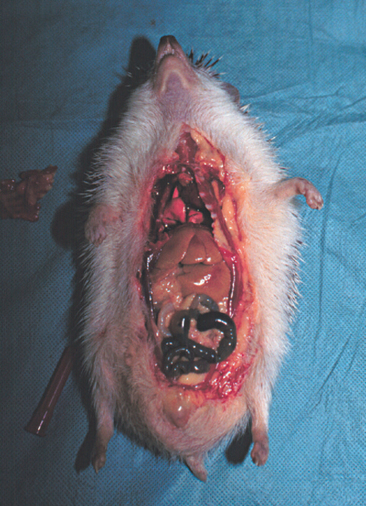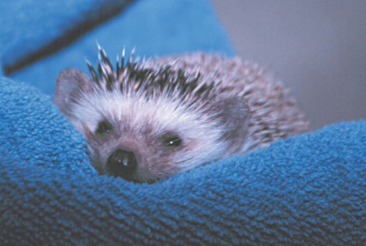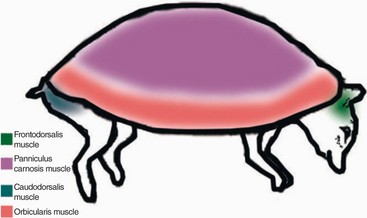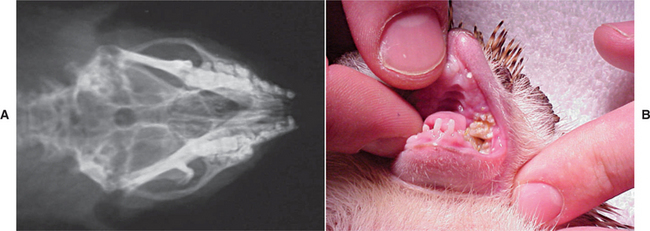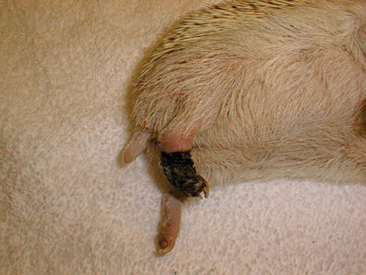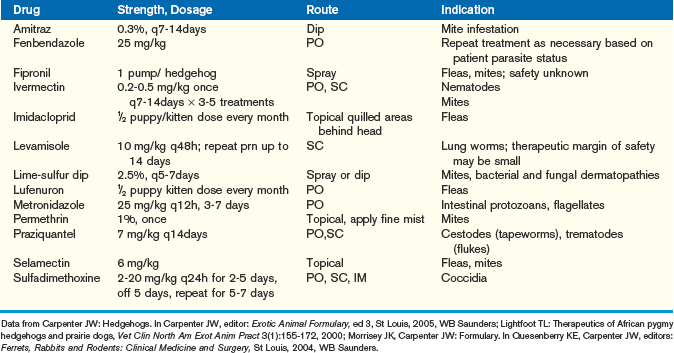CHAPTER 16 HEDGEHOGS
COMMON SPECIES KEPT IN CAPTIVITY
Hedgehogs are members of the order Erinaceomorpha, family Erinaceidae, subfamily Erinaceinae. The 12 species from 5 genera are widespread throughout the Old World (e.g., Africa, Europe, and Asia),1 though they are not found in central Asia, including India, Nepal, Pakistan, Tibet, and western equatorial Africa. Hedgehogs are classified based on the shape and pattern of their spines, ear length, and skull morphology.2 Commonly encountered species include Atalerix albiventris, also known as the white-bellied or four-toed African pygmy hedgehog from central Africa, and Erinaceous europaeus, the European hedgehog of western Europe. The Atalerix genus has other members, including Pruner’s hedgehog (A. pruneri), the Algerian hedgehog (A. algirus), Sclater’s hedgehog (A. sclateri), and the Cape hedgehog (A. frontalis).3 Other hedgehog genera include the desert hedgehogs (Paraechinus spp.) from the Middle East and North Africa; the long-eared hedgehogs (Hemiechinus spp.) from Asia, India, and North Africa; and the Daurian hedgehogs (Mesechinus spp.) from China. Hedgehog classification, however, is somewhat confusing, as some consider the Atalerix genus part of the Erinaceus genus.3,4 Of these hedgehog species, only the African pygmy hedgehog (A. albiventris) and the European hedgehog (E. europaeus) are considered acceptable—based on temperament—as pets.5 There are currently no hedgehog species considered vulnerable to extinction; however, the Cape hedgehog listed in CITES appendix 2 is rare. Decline of this species may have been caused by loss of habitat, or its popularity as a local delicacy and pet.2,3,6
Reviews of disease and rehabilitation of the European hedgehog are readily available, as this is the most thoroughly studied of the hedgehog species.7–11
This chapter will focus on the African pygmy hedgehog, as it is the most common species encountered in the North American pet trade. Importation of the European hedgehog and other species of hedgehogs is strictly controlled. However, information known from hedgehog species in general will be included where the generality applies to this species. The importation of the African pygmy hedgehog to the United States has been prohibited since 1991 because of their potential to carry foot-and-mouth disease.12 This species is native to central Africa, from Senegal to Sudan and Zambia, in an area stretching from the southern part of the Sahara to the Congo and into East Africa. The African pygmy hedgehog has even been found on Mount Kilimanjaro at elevations of 1800 m.3 Color varieties found in the pet trade include the standard colored quill, “salt and pepper,” and the all-white quilled “snowflake.”
BIOLOGY AND BEHAVIOR
Antipredator defenses include not only the spiny pelage, but the ability to roll into a tight ball to protect the feet, face, and soft underbelly. Hedgehogs possess a protein, erinacin, which can be extracted from their muscles and inhibits the hemorrhagic and proteolytic activity of venom.1,13 However, the in vivo protection this affords hedgehogs, although the stuff of folktales, remains unknown and may be incomplete and individually variable. Nonetheless, this attribute, along with their protective spines, likely gives hedgehogs the ability to attack and eat snakes.
Hedgehogs are predominantly solitary creatures. These animals have relatively small eyes; therefore, it is believed that they rely on olfactory and auditory cues for communication.2 Thus, vocalizations of A. albiventris are multiple and varied (Box 16-1).2,14–15 Hedgehogs have a well-developed sense of smell to find food and get information about others of their species.2
BOX 16-1 African pygmy hedgehog (Atalerix albiventris) vocalizations
| Sound | Description |
|---|---|
| Snorting/huffing | Aggressive or warning sounds produced by sharp vibrating exhalations through the nostrils. Generally made when the animal is disturbed, when it encounters another animal, or when it is in the process of rolling up. |
| Hissing/grunting | |
| Screaming | A severe distress call given when the animal is in distress or pain. |
| Twittering/whistling | High-pitched sounds of neonates. Whistling stimulates contact by the dam. |
| Clucking | High-pitched contact call of the dam to neonates, also made by courting males. |
| Snuffling | Made as hedgehogs search for food. |
| Inaudible sounds | Hedgehogs can make and hear sounds in the 40- to 90-kHz range, above the range of human hearing. |
Anting, or anointing, is a feature of all hedgehog species. In this strange behavior, the hedgehog encounters a substance, may lick or chew the substance, and then begins to hypersalivate to produce copious foamy saliva which is then slathered onto the spines of the flank and back with the tongue. Food bits may be found on the quills from this behavior. Direct contact with a substance is not necessary to elicit this behavior, which is commonly caused by anesthetic gases as well as perfume. This behavior has also been induced by strong smelling substances such as cigarettes, glue, toad skin, leather, creosote, cat food, fish, wool, various plants and vegetables, foxes, and other hedgehogs.2,13,16 The true purpose of anointing remains unknown, but theories explaining its purpose in the hedgehog include reduction of skin parasites, predator deterrence, mate attraction, and communication among conspecifics by imparting an odor to each animal in its home range.2,16 This behavior can occur in the African pygmy hedgehog as early as 15 days of age.
The African pygmy hedgehog is nocturnal in captivity but will emerge from its nest during the day.3 In the wild, these creatures will rest by day, curled underneath matted grass, leaf litter, or in a rock crevice or hole in the ground.6 These resting places are changed daily unless the animal has a litter or is in hibernation or torpor. In nature, hedgehogs are active and gain weight in the rainy season and enter hibernation when the weather is cool and dry, from about June to September. During this period, animals may remain torpid for up to 6 weeks but emerge in periods of warm weather.6 In captivity, hibernation is not considered physiologically necessary for African pygmy hedgehogs. African pygmy hedgehogs are an adaptable species and have been found in a wide variety of habitats, such as grassland, scrub, savannah, and even suburban gardens.6 However, they are generally absent from areas of extreme heat or cold, such as deserts, marshes, and dense forest.
UNIQUE ANATOMY AND PHYSIOLOGY
The African pygmy hedgehog has a variety of unique anatomic features that make clinical examination and treatment challenging (Figure 16-1).
Integumentary System
The most characteristic feature of the hedgehog is the spiny pelage.1 In common with all hedgehogs except the long-eared genera, the African pygmy hedgehog has a narrow spineless tract on the crown of the head, which runs rostrocaudally for about 2 cm and is about 0.5 cm wide.15 Spines cover the dorsum of the body overlying a thin epidermis, a thick dermal fibrous layer, and a loose layer of fat and subcutaneous tissue that is poorly vascularized. Spines give way to true, white hair on the ventrum and legs, whereas the muzzle and feet are essentially hairless. Hair and sebaceous glands are absent in the spined region; however, sweat glands and sebaceous glands are present in the haired regions and on the soles of the feet.16
At birth, hedgehogs are equipped with white soft spines that harden within a few hours.3 A second set of harder darker spines emerges 2 days after birth.3 The spines of the adult wild type African pygmy hedgehog are white at the base and tip with a central dark black or brown band (Figure 16-2). This band coloration is darker or lighter depending on the animal’s native geographic range.
The quills or spines are not detached easily, are firm, measure from 0.5 to 2 cm, are relatively uniform in length and diameter, and have needle-sharp unbarbed quill tips.17 The average adult hedgehog carries about 5000 spines, which are predominantly in telogen.13,17 Spines may last up to 18 months and are individually replaced.16 These spines are modified hair, each filled with a spongy matrix inside the outer fibrous cortex.17,18 At its insertion into the skin, the base of the spine tapers and then forms a cup-shaped bulb that is embedded in the skin.17,18 This structure allows force applied to the spine by a blow or fall to be transferred into the spine, causing it to bend at the base rather than transferring force into the hedgehog.19 These spines may be difficult to remove, as traction causes them to break midshaft.17
Musculoskeletal System
Whereas most hedgehogs have five toes on all feet, the African pygmy hedgehog only has four toes on the pes; the hallux is absent.15 Hence, it is also known as the four-toed hedgehog.2 The toenails are highly curved caudally and are round in cross section.16 Another anatomic trait of the hedgehog is a distally fused radius and ulna.16 The normal stance is plantigrade, with the ventrum held slightly off the ground.16 Hedgehogs can run at up to 2 m/sec, but they usually walk slowly with a toddling or waddling gate.2
The most interesting feature of the hedgehog musculoskeletal system is the complex of muscles that erect and position the spines and curl the hedgehog into a ball (Figure 16-3). This complex of muscles consists of the frontodorsalis and caudodorsalis muscles, which move the spines down over the rump and forehead; the panniculus carnosus muscle, which rolls up the hedgehog; and the orbicularis muscle, which pulls the mantle of spines together as a drawstring. In the fully curled position, only a 1-cm diameter ventral opening is left that is not covered by spines. In this completely balled up position, the head, ventrum, and feet are not visible. If only somewhat disturbed, the hedgehog will just use the frontodorsalis and caudodorsalis muscles to pull the spines forward and down on the forehead and down and back over the rump. The position affords protection to the face and rump and still allows the hedgehog to see and hear. The rump is an area where hedgehogs are likely to be bitten by other hedgehogs, and the position of the spines forward over the face allows the hedgehog to ram other hedgehogs or attackers with the forward-facing spines. When engaging all the muscles of rolling, the hedgehog curls into a spiny ball and generally vibrates and hisses. If necessary, the hedgehog can stay in the position of a spiny ball for hours.
Reproductive System
The sex of African hedgehogs can be determined by their external anatomy. Males have a prepuce located midway along the ventral abdomen. The penis is spineless and has lateral horns on either side of the meatus, making it resemble a snail’s head.20 The male hedgehog lacks a scrotum, but the testicles are palpable in the subcutaneous para-anal recesses.20 The male hedgehog is generally accepted to have multilobed seminal vesicles, a bilobed prostate and paired Cowper’s glands as accessory sex glands.15 Hedgehog sperm normally have an offset or eccentrically positioned tail.20
The vulva of the female is located close to the anus, resulting in a decreased anogenital distance similar to rodent species. Female A. albiventris have three pairs of mammae. The urethra opens into the distal vagina several millimeters from the vulva.16 The large, thin-walled vagina is always patent, located within the abdominal cavity, and is flanked on each side by large, fan-shaped glands homologous to the Cowper’s gland of the male.16 The female hedgehog has a bicornuate uterus and a single muscular cervix; there is no uterine body.20 Short (7.5 mm) fallopian tubes emerge from each side of each uterine horn, and the mesosalpinx and ovarian bursa are relatively fat laden.20 The ovaries are held within a tough peritoneal capsule. Reproductive and other biological characteristics of the African hedgehog are summarized in Box 16-2.
BOX 16-2 Biological and reproductive characteristics of the African pygmy hedgehog (Atalerix albiventris)
Data from Smith AJ: Husbandry and medicine of African hedgehogs, J Small Exot Anim Med 2(1):21–28, 1992; Smith AJ: Husbandry and nutrition of hedgehogs, Vet Clin North Am Exot Anim Pract 2(1):127–141, 1999; Bedford J, Mock O, Nagdas S et al: Reproductive characteristics of the African pygmy hedgehog Atalerix albiventris, J Reprod Fertil 120 : 143–150, 2000; Smith AJ: Neonatology of the hedgehog (Atalerix albiventris), J Small Exot Anim Med 3(1):15–18, 1995; Larson RS, Carpenter JW: Husbandry and medical management of African hedgehogs, Vet Med Oct: 877–890, 1999; Carpenter JW: Hedgehogs. In Carpenter JW, editor: Exotic Animal Formulary, ed 3, St Louis, 2005, WB Saunders.
| Parameter | Atalerix albiventris |
|---|---|
| Life expectancy | Wild 1-4 yr, captive 5-10 yr, average 3-8 yr |
| Male adult weight | 500-600 g |
| Female adult weight | 250-400 g |
| Rectal temperature | 36.1°-37.2° C (97°–99° F) |
| Body length | 17-25 cm (7-9in) |
| Heart rate | 180-280 beats/min |
| Respiratory rate | 25-50 breaths/min |
| Preferred enclosure temperature | 24°–27° C (75°–80° F) |
| Male sexual maturity | 2-6 mo |
| Female sexual maturity | 6-8 mo |
| Ovulation | Induced |
| Gestation period | 32 days |
| Milk composition | Fat 25.5 g/100 g, protein 16 g/100 g, trace carbohydrates |
| Litter size | 1-7 young (average 3) |
| Birth weight | 8-13 g |
| Eyes open | 13-16 days |
| Weaning age | 4-6 wk, eating solid foods starting week 3 |
| Tooth eruption | |
| Deciduous | Starts day 18, all erupted by 9 wk |
| Permanent | Begins at 7-9 wk |
Alimentary Tract
The teeth and lips are a characteristic morphological feature of the hedgehog.24 In all hedgehogs the first upper two molars are low and cusped, the labial styles are reduced to a cingulum, and the first two lower molars are subrectangular.24 Hedgehogs are adapted for an omnivorous diet with stronger jaws and blunter teeth than most insectivores, along with brachydont or closed rooted teeth.15 Short incisors, canines, and prominently cusped molars grip and penetrate food, whereas the flattened crowns and multiple cusps of the molars crush the food.25 The upper incisors are separated by a wide gap into which the blunt, forward-projecting lower incisors fit (Figure 16-4). When a hedgehog bites down, the lower incisors scoop and lift the insect to the upper incisors, which impale the prey.2 Hedgehogs can also inflict a similar bite on the handler. The dental formula of A. albiventris is I 3/2 C1/1 P3/2 M3/3 for a total of 36 teeth.
The hedgehog gastrointestinal tract is relatively short and simple, as in other insectivores, with a 12- to 16-hour transit time.15 The stomach is simple, but a vomit response is present.16 The colon in noncomplex, and there is no cecum. Hedgehogs have anal glands, but they are not well developed.2
Neurology and Special Senses
The small cerebrum of the hedgehog suggests that the learning ability of this animal may be somewhat less than that of the rodent or carnivore. However, hedgehogs can recognize their owner and understand simple commands if trained.16 Hedgehogs have relatively small eyes for their body size, and the retina contains only rod cells, thus allowing only for discrimination of some colors with bright lighting.15 Hearing of the hedgehog is particularly sensitive to high-frequency sounds. These senses may be used for location and capture of prey but can also elicit a defensive posture in the hedgehog.15 Olfaction is the best developed special sense in the hedgehog. The hedgehog olfactory lobes of the brain and the vomeronasal organ are well developed. Olfactory cues are used by hedgehogs in orientation, navigation, intraspecific communication, predator detection, prey and food detection, and as the signal for initiating the self-anointing behavior.2,15
HUSBANDRY
Appropriate substrate should be provided. A soft absorbent material, such as shredded newspaper, recycled newspaper product, pelleted cat or bird litter, or other materials, such as crushed corncobs or alfalfa pellets of about a 3″ depth, is recommended to provide an environment for the animal to dig and explore. Aromatic wood shavings, especially cedar, should be avoided because their volatile compounds can cause dermatitis of the ventrum and feet. For a natural display, wood chips, sphagnum moss, or soil may be used; however, these are generally avoided because they are difficult to clean. Potted plants may also provide hiding places and increase humidity, but a hedgehog enclosure is not particularly healthy for the potted plants. Avoid plants with toxic leaves, stems, flowers, berries, or roots. Avoid terry cloth towels or other fabrics, as the hedgehog may ingest these fibers or entangle its feet, resulting in necrosis of the foot and necessitating amputation (Figure 16-5). Change the bedding frequently and spot-clean daily to avoid dermatitis and other problems of urine and fecal soiling of the cage. Hedgehogs can be taught to use a litter box, but one should avoid clumping or clay litter, which attaches to the perineal and preputial areas. Litter attached to these sensitive areas may cause urinary or fecal blockage.
Housing Multiple Hedgehogs
Hedgehogs are solitary animals in the wild and are easily maintained as single pets in captivity. If multiple animals are housed together, each animal should have least one hide box. Animals that have been raised together may tolerate each other better as adults, but as a rule only a single male is kept per group. Housing multiple adult males together may result in fighting and a disproportionate food intake. Males can damage each other with their teeth and spines.4 Hedgehogs often bite cagemates on the hind legs in the area without spines.16 Groups of up to three females with a male, a harem, or without a male are best. However, fighting can arise between either sex, and any new addition to an established group should be closely monitored.26 Zoonotic disease transmission has occurred more than once from herds of hedgehogs.12 Housing a group of hedgehogs demands attention to appropriate sanitation.
Should one choose to own multiple hedgehogs, permanent identification is highly recommended, especially if they cohabitate or interact with each other. Identification of hedgehogs can be accomplished by a number of methods. Ear tags and tattoos have been used but are discouraged, as these markings are obscured when the hedgehog rolls up. Microchipping is the preferred method of identification. Microchips can be placed in the subcutaneous dorsal fat pad between the shoulders (between the spines) as for many small mammals. Anesthesia can facilitate appropriate placement. Animals may also be identified in a semipermanent fashion, by marking the spines with nontoxic permanent markers or nontoxic fabric paint.4,16,22 Both spine markings and the transponder microchips have the advantage of accessibility when the animal is in its defensive posture.
NUTRITION
The exact dietary requirements for hedgehogs have not been determined. Few accounts exist for the diet of the wild African hedgehog (Box 16-3).6,15 However, the African hedgehog has been maintained and bred successfully in captivity on a variety of diets (Box 16-4). As in other species, caloric and nutritional requirements probably vary based on age, reproductive status, gender, and activity level. Nutritional recommendations should be adjusted based on these factors. In all wild hedgehogs, insects constitute the bulk of the diet; however, plant material, vertebrates, eggs, mollusks, and carrion are also consumed.
BOX 16-3 Dietary items of the wild African hedgehog
| Invertebrates | Vertebrates | Plants |
|---|---|---|
| Ants | Frogs | Roots |
| Earthworms | Lizards | Fungi |
| Slugs | Snakes | Fruit |
| Beetles | Bird eggs | |
| Snails | Chicks | |
| Small rodents |
In captivity, hedgehogs have a tendency to become obese. Further, a predominantly captive insect diet, high in fat and with an inappropriate calcium-to-phosphorous ratio, may also increase the likelihood of secondary nutritional hyperparathyroidism. A base diet of reduced calorie, small kibble cat or dog chow provides an appropriate calcium-phosphorous balance while limiting caloric intake. A commercially available hedgehog diet can also form the base of the diet but should not be used as the sole diet because it is unknown whether the total nutritional requirement of the hedgehog is met. Preliminary studies show that fiber improves fecal quality and that hedgehogs are able to break down fiber.27 Thus, small amounts of mixed fruits and vegetables and occasional live insects, especially those with chitinous exoskeletons, should form a regular part of the hedgehog’s diet. Intake of dry kibble and insects with chitinous exoskeletons may also improve dental and gingival health. Hedgehogs develop food preferences; therefore, it is recommended that one offer a variety of foods early in life (Box 16-4). Avoid giving nuts or grains, which may become lodged in the gingival tissue and/or oral cavity, and milk, which may cause diarrhea.28
Hospital Diets
Hospitalized hedgehogs should be offered a high-quality diet, as described in the previous section, and weighed daily. The patient should be fed its normal diet. In the case of the anorectic hedgehog, or the hedgehog that is losing weight, additional measures may be necessary to assure adequate nutritional intake. Syringe feeding of a high-caloric, wet, cat or dog food, powdered, high-energy, carnivore diet or human enteral diets with sweet flavoring added can be tried. Placement and maintenance of nasogastric or esophagostomy tubes is problematic because of the small size and defensive nature of this species. However, pharyngostomy tubes have been placed with success in this species, using methods applied to the feline patient.28
PREVENTIVE MEDICINE
Health Maintenance
Currently, there are no vaccines labeled for use in hedgehogs. However, the wild African hedgehog has been found to be serologically positive for exposure to Leptospira spp.29 Rabies and Morbillivirus infection closely related to distemper have been diagnosed in the closely related European hedgehog.12,29 Because hedgehogs are generally not housed in mixed gender groups, castration or ovariohysterectomy is not generally requested or recommended. Nevertheless, castration and ovariohysterectomy can be performed without incident.30,31 Although the incidence of uterine tumors and mammary tumors is a concern, the effect of early age ovariohysterectomy on tumor reduction is unknown (see Surgery). Fleas and ticks are not generally a problem in captive African pygmy hedgehogs, but mite infestations can be severe. Several monthly antiparasitic products have been used in hedgehogs without apparent ill effects (see Ectoparasites and Table 16-3) and therefore may be used in the multiple hedgehog household.
Stay updated, free articles. Join our Telegram channel

Full access? Get Clinical Tree


